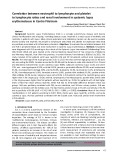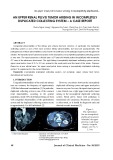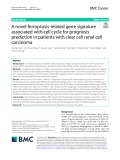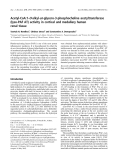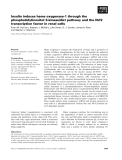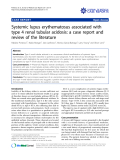
Renal systems
-
Systemic Lupus Erythematosus (SLE) is a complex autoimmune disease with diverse clinical manifestations and relapsing - remitting disease course. To evaluate the correlation between NLR and PLR in peripheral blood and renal involvement in systemic lupus erythematosus.
 7p
7p  vifaye
vifaye
 20-09-2024
20-09-2024
 1
1
 1
1
 Download
Download
-
Congenital abnormalities of the kidney and urinary tract are common. In particular, the duplicated collecting system is one of the most common kidney abnormalities, but most are asymptomatic. The pathogenesis of these abnormalities is also known very little and some pathogenic genes are thought to be related.
 5p
5p  vinatisu
vinatisu
 29-08-2024
29-08-2024
 2
2
 1
1
 Download
Download
-
It is of great urgency to explore useful prognostic markers for patients with clear cell renal cell carcinoma (ccRCC). Prognostic models based on ferroptosis-related gene (FRG) in ccRCC is poorly reported for now.
 11p
11p  vielonmusk
vielonmusk
 21-01-2022
21-01-2022
 23
23
 1
1
 Download
Download
-
Platelet-activating factor (PAF) is one of the most potent inflammatory mediators. It is biosynthesized by either the de novobiosynthesis of glyceryl ether lipids or by remodeling ofmembranephospholipids. PAFis synthesizedandcatabo-lizedbyvarious renal cells andtissues andexerts awide range of biological activities on renal tissue suggesting a potential role during renal injury.
 9p
9p  fptmusic
fptmusic
 16-04-2013
16-04-2013
 50
50
 4
4
 Download
Download
-
Heme oxygenase-1 catalyzes the breakdown of heme and is protective in models of kidney transplantation. In this study we describe the induction of heme oxygenase-1 mRNA and protein by insulin. Following treatment with insulin, a five-fold increase in heme oxygenase-1 mRNA and a four-fold increase in protein expression were observed in renal adenocarcinoma cells; insulin-induced heme oxygenase-1 expression was also demonstrated in mouse primary tubular epithelial cells.
 12p
12p  inspiron33
inspiron33
 26-03-2013
26-03-2013
 57
57
 4
4
 Download
Download
-
Angiotensin-converting enzyme (ACE) and its homologue angiotensin-converting enzyme 2 (ACE2) are critical counter-regulatory enzymes of the renin–angiotensin system, and have been implicated in cardiac function, renal disease, diabetes, atherosclerosis and acute lung injury.
 10p
10p  vinaphone15
vinaphone15
 28-02-2013
28-02-2013
 39
39
 3
3
 Download
Download
-
Despite the aberrant expression of cholinesterases in tumours, the question of their possible contribution to tumorigenesis remains unsolved. The identifica-tion in kidney of a cholinergic system has paved the way to functional studies, but details on renal cholinesterases are still lacking. To fill the gap and to determine whether cholinesterases are abnormally expressed in renal tumours, paired pieces of normal kidney and renal cell carcinomas (RCCs) were compared for cholinesterase activity and mRNA levels....
 11p
11p  viettel02
viettel02
 19-02-2013
19-02-2013
 33
33
 2
2
 Download
Download
-
The mammalian natriuretic peptide system, consisting of at least three ligands and three receptors, plays critical roles in health and disease. Exam-ination of genetically engineered animal models has suggested the signifi-cance of the natriuretic peptide system in cardiovascular, renal and skeletal homeostasis.
 12p
12p  cosis54
cosis54
 05-01-2013
05-01-2013
 43
43
 4
4
 Download
Download
-
Tuyển tập báo cáo các nghiên cứu khoa học quốc tế ngành y học dành cho các bạn tham khảo đề tài: Systemic lupus erythematosus associated with type 4 renal tubular acidosis: a case report and review of the literature...
 5p
5p  thulanh26
thulanh26
 08-12-2011
08-12-2011
 52
52
 6
6
 Download
Download
-
Invasive Disease The treatment of a tumor that has invaded muscle can be separated into control of the primary tumor and, depending on the pathologic findings at surgery, systemic chemotherapy. Radical cystectomy is the standard, although in selected cases a bladder-sparing approach is used; this approach includes complete endoscopic resection; partial cystectomy; or a combination of resection, systemic chemotherapy, and external beam radiation therapy. In some countries, external beam radiation therapy is considered standard.
 5p
5p  konheokonmummim
konheokonmummim
 03-12-2010
03-12-2010
 61
61
 4
4
 Download
Download
-
Death and Dying The most common causes of death in patients with cancer are infection (leading to circulatory failure), respiratory failure, hepatic failure, and renal failure. Intestinal blockage may lead to inanition and starvation. Central nervous system disease may lead to seizures, coma, and central hypoventilation. About 70% of patients develop dyspnea preterminally. However, many months usually pass between the diagnosis of cancer and the occurrence of these complications, and during this period the patient is severely affected by the possibility of death. ...
 5p
5p  konheokonmummim
konheokonmummim
 03-12-2010
03-12-2010
 97
97
 6
6
 Download
Download
-
Disease-Specific Nutritional Support SNS is basically a support therapy and is primary therapy only for the treatment or prevention of malnutrition. Certain conditions require modification of nutritional support because of organ or system impairment. For instance, in nitrogen accumulation disorders, protein intake may need to be reduced. However, in renal disease, except for brief periods of several days, protein intakes should approach requirement levels of at least 0.8 g/kg or higher up to 1.2 g/kg as long as the blood urea nitrogen does not exceed 100 mg/dL.
 5p
5p  konheokonmummim
konheokonmummim
 03-12-2010
03-12-2010
 77
77
 5
5
 Download
Download
-
Underlying Systemic Diseases that Cause or Exacerbate a Bleeding Tendency Acquired bleeding disorders are commonly secondary to, or associated with, systemic disease. The clinical evaluation of a patient with a bleeding tendency must therefore include a thorough assessment for evidence of underlying disease. Bruising or mucosal bleeding may be the presenting complaint in liver disease, severe renal impairment, hypothyroidism, paraproteinemias or amyloidosis, and conditions causing bone marrow failure.
 5p
5p  konheokonmummim
konheokonmummim
 03-12-2010
03-12-2010
 81
81
 4
4
 Download
Download
-
Also systemic. f In adults, associated with renal failure and immunocompromised state. Vesicles and bullae are also seen in contact dermatitis, both allergic and irritant forms (Chap. 53). When there is a linear arrangement of vesicular lesions, an exogenous cause should be suspected. Bullous disease secondary to the ingestion of drugs can take one of several forms, including phototoxic eruptions, isolated bullae, Stevens-Johnson syndrome (SJS), and toxic epidermal necrolysis (TEN) (Chap. 56).
 4p
4p  konheokonmummim
konheokonmummim
 30-11-2010
30-11-2010
 82
82
 5
5
 Download
Download
-
Approach to the Patient: Hyperchloremic Metabolic Acidoses In diarrhea, stools contain a higher [HCO3–] and decomposed HCO3– than plasma so that metabolic acidosis develops along with volume depletion. Instead of an acid urine pH (as anticipated with systemic acidosis), urine pH is usually around 6 because metabolic acidosis and hypokalemia increase renal synthesis and excretion of NH4+, thus providing a urinary buffer that increases urine pH. Metabolic acidosis due to gastrointestinal losses with a high urine pH can be differentiated from RTA (Chap.
 5p
5p  ongxaemnumber1
ongxaemnumber1
 29-11-2010
29-11-2010
 85
85
 3
3
 Download
Download
-
Metabolic Acidosis Metabolic acidosis can occur because of an increase in endogenous acid production (such as lactate and ketoacids), loss of bicarbonate (as in diarrhea), or accumulation of endogenous acids (as in renal failure). Metabolic acidosis has profound effects on the respiratory, cardiac, and nervous systems. The fall in blood pH is accompanied by a characteristic increase in ventilation, especially the tidal volume (Kussmaul respiration). Intrinsic cardiac contractility may be depressed, but inotropic function can be normal because of catecholamine release.
 5p
5p  ongxaemnumber1
ongxaemnumber1
 29-11-2010
29-11-2010
 72
72
 4
4
 Download
Download
-
Harrison's Internal Medicine Chapter 48. Acidosis and Alkalosis Normal Acid-Base Homeostasis Systemic arterial pH is maintained between 7.35 and 7.45 by extracellular and intracellular chemical buffering together with respiratory and renal regulatory mechanisms. The control of arterial CO2 tension (PaCO2) by the central nervous system and respiratory systems and the control of the plasma bicarbonate by the kidneys stabilize the arterial pH by excretion or retention of acid or alkali.
 5p
5p  ongxaemnumber1
ongxaemnumber1
 29-11-2010
29-11-2010
 88
88
 4
4
 Download
Download
-
Table 47-2 Causes of Hypocalcemia Low Parathyroid Hormone Levels (Hypoparathyroidism) Parathyroid agenesis Isolated DiGeorge syndrome Parathyroid destruction Surgical Radiation Infiltration by metastases or systemic diseases Autoimmune Reduced parathyroid function Hypomagnesemia Activating CaSR mutations High Parathyroid Hormone Levels (Secondary Hyperparathyroidism) Vitamin D deficiency or impaired 1,25(OH)2D production/action Nutritional vitamin D deficiency (poor intake or absorption) Renal insufficiency with impaired 1,25(OH)2D production Vitamin D resistance, inclu...
 5p
5p  ongxaemnumber1
ongxaemnumber1
 29-11-2010
29-11-2010
 70
70
 4
4
 Download
Download
-
A detailed history may provide important clues regarding the etiology of the hypercalcemia (Table 47-1). Chronic hypercalcemia is most commonly caused by primary hyperparathyroidism, as opposed to the second most common etiology of hypercalcemia, an underlying malignancy. The history should include medication use, previous neck surgery, and systemic symptoms suggestive of sarcoidosis or lymphoma. Once true hypercalcemia is established, the second most important laboratory test in the diagnostic evaluation is a PTH level using a two-site assay for the intact hormone.
 5p
5p  ongxaemnumber1
ongxaemnumber1
 29-11-2010
29-11-2010
 75
75
 5
5
 Download
Download
-
Harrison's Internal Medicine Chapter 45. Azotemia and Urinary Abnormalities Azotemia and Urinary Abnormalities: Introduction Normal kidney functions occur through numerous cellular processes to maintain body homeostasis. Disturbances in any of these functions can lead to a constellation of abnormalities that may be detrimental to survival.
 8p
8p  ongxaemnumber1
ongxaemnumber1
 29-11-2010
29-11-2010
 86
86
 4
4
 Download
Download
CHỦ ĐỀ BẠN MUỐN TÌM








